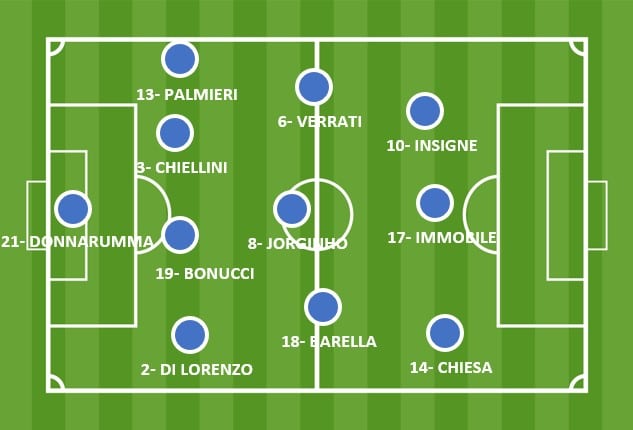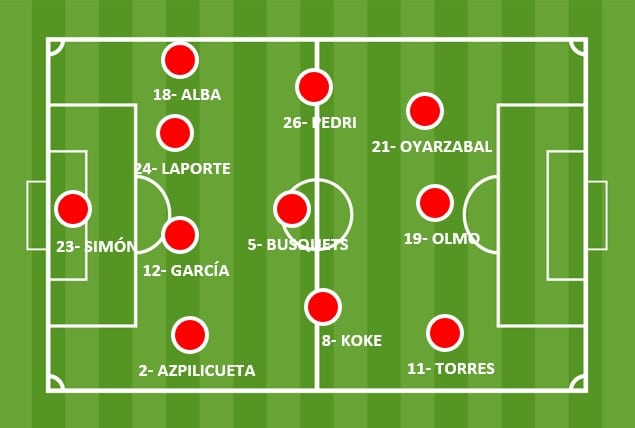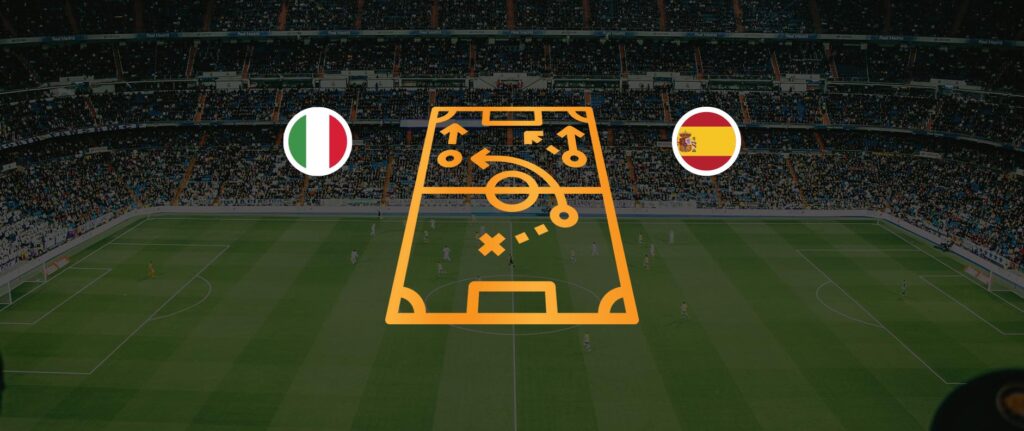Wembley was the scene of the semifinal between Italy and Spain, with the refereeing of the German Felix Brych where the team led by Roberto Mancini won the penalty series 4 to 2. After drawing a match where the Spanish team was characterized by implementing some Tactical variants that represented the difference in their game strategy, such as the entry of the player Dani Olmo performing as a false “9”.
The Spanish team, leading by Luis Enrique, was a clear dominator of the match, but Italy through a work of pressure of great intensity (as we will see later) manifested its presence and power through a well-used counterattack.
Both teams used a 1-4-3-3 tactical system. Italy at times varied to a 1-4-1-4-1 system and Spain presented a 1-4 tactical system in their eagerness to counteract the pressure from Italy.
Italy Initial Tactical Disposition

Initial Tactical Provision of Spain

Nuances between the two teams were manifested in terms of the development of the game from the first phase of the game.
On the one hand, Italy referenced an elaborate start of the game, through an exit with 2 center-backs located in their own area, and the side variant or the lowering of the pivot or both interiors using a short combined exit model, trying to progress with an orderly start. Although it cost him to maintain that starting order, having to resort to long throws behind the opponent’s 3rd line.
On the Spanish side, their output was from 4 players, pure type, using a Short Combined game mode, with some intentions of a Mixed Output model and on few occasions Direct Play.
The aforementioned is exemplified below:
Ball Moment / Italy Start of Play
Ball Moment / Spain Start of Play
With regard to the development phase in the attack, there were 2 well-marked scenarios.
Spain, reaching the rival field position with a clear dominance and with many players in the field and rival area, and Italy with a game based on pressure (as mentioned above), a constant, active, and danger kickbacks, using Chiesa as a relevant option.
From the advantage on the scoreboard, Italy maintained a backward defense opting for the counterattack game. After the draw of Spain, Italy had to make modifications and could not settle, due to the variant imposed by Luis Enrique, opting at times to a 1-4-2-3-1, with he was forced to advance the team, joining the lines and forcing to cut the Spanish gaming circuit. Then you can see:
Ball Moment / Offensive Phase Italy
Ball Moment / Offensive Phase Spain
A detail to highlight in this analysis is the pressure process carried out by the Italian team (which it had been carrying out in previous games). In the following images, you can really see how both Immobile (who was replaced by Berardi), Berardi himself, and Then Chiesa did a great job permanently demanding the rival, submitting it, and trying to win back from quick and effective combinations.
No Ball Moment / Pressure Phase Italy
Beyond the good times of Spain, with a showy and orderly game, Italy, with an air of renewed style was able to achieve, from a conviction and proactive attitude, to be a clear and fair winner.

Comments are closed.